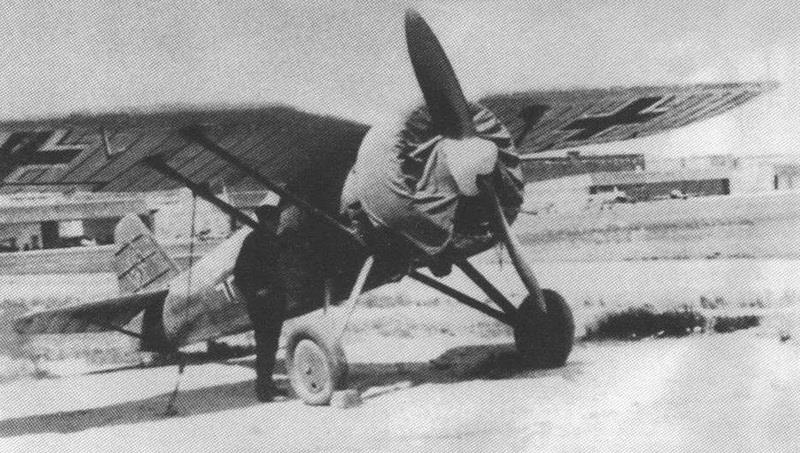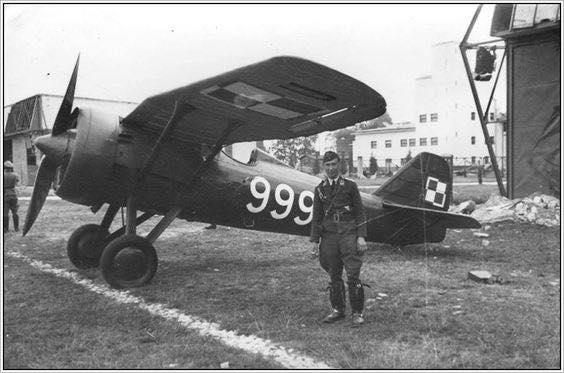The German troops captured approx. 40 airplanes of type of the PZL P 7a, some at CWL in Deblin. the-remaining were found at different other places. The machines, which were -found in the best condition, approx. ten units, were refurbished and equipped with parachutes of German type also replaced the old Vickers MG by of MG of German design. In the summer 1941,with these machines, a training unit was formed, which was stationed in Deblin. According to Polish sources, this type were also shown on the airfield Jüterbog/Damm,Berlin. Possibly the training unit was moved to Germany. It is not known, how long the machines were in use by the Luftwaffe. It cannot been a very long period, since the engines of the airplanes were already worn out.
The history of the PZL P.7 began in 1928, when a talented designer named Zygmunt Puławski designed an all-metal, metal-covered monoplane fighter, the PZL P.1. It introduced a high gull wing, giving a pilot an optimal view. The wing design was called the "Polish wing" or "Pulawski wing." The P.1 was powered by an inline engine and developed a speed of 302 km/h. But it remained a prototype because a decision was made to use a licence-produced radial engine in the Polish Air Force fighters. So the next model, the PZL P.6, flown in August 1930, was powered by the Bristol Jupiter VI FH radial engine. Both aircraft were well received in the aviation world, with the press recognizing the P.6 as one of the world's top fighters; it won the American National Air Races in August-September 1931.
The PZL P.6 did not enter production because the next variant, the more advanced PZL P.7, was developed. The first prototype was basically the P.6 with a more powerful Bristol Jupiter VII F engine. Due to the use of a supercharger, it had better performance at higher altitudes. The prototype P.7/I was first flown in October 1930 by Bolesław Orliński.[1] Initially, engine cylinders had individual cylinder clearance fairings. After some changes, most noticeably adding a wide Townend ring to the engine and making the tail slimmer, the second prototype P.7/II, built in autumn 1931, was accepted for production with the designation P.7a. It also featured a redesigned wing with slightly increased span, taken from the PZL P.8, and shorter ailerons and smooth upper surfaces, instead of ribbed ones.
The first series P.7a planes were built in mid-1932. The whole series of 149 (plus two prototypes) was completed in 1933. They carried military serial numbers 6.1 to 6.150 (the first prototype P.7/I had no assigned number). The Polish Air Force received the P.7a in 1933.
After designing the P.7, Puławski started to develop his design with more powerful engines, and the result was the PZL P.11, built in a production series.[2] Puławski was an inline engine fan, designing a new fighter, the P.8, with a slim silhouette, powered with an inline engine. It was able to reach a speed of 350 km/h. A planned variant was to be designated the P.9. Unfortunately, in March 1931, Puławski died in an air crash, and the inline engine fighter design was cancelled in favour of the radial engined P.11. The P.11 became the standard Polish fighter. In parallel with the P.11, the PZL P.24 export variant was also developed in 1932.
The all-metal, duralumin metal-covered monoplane aircraft was conventional in layout, with braced, high gull wing and fixed undercarriage with a rear skid. The two-spar wing of trapezoid shape, thinner by the fuselage, was covered with a rimmed Wibault type duralumin sheet (upper surfaces were smooth) and supported by two struts on either side. The fuselage was framed in a front section and semi-monocoque in mid- and tail sections, oval in cross-section. In keeping with the period, the pilot's cockpit was open with a windshield. The armament was two 7.92 mm machine guns mounted on the fuselage sides (initially 7.7 mm Vickers E, then re-bored to 7.92 mm). The aircraft was powered by the Bristol Jupiter VII F radial engine (normal power: 480 hp (360 kW), maximum: 520 hp (390 kW) and fitted with a Townend ring and two-blade propeller. A main 290 l fuel tank in the fuselage, behind the engine, could be dropped in case of fire emergency. The second fuel tank was 7 l.
The PZL P.7a entered service in spring 1933, replacing PWS-A (licence Avia BH-33) and PWS-10 fighters. Consequently, the Polish Air Force became the world's first air force entirely equipped with all-metal monococque fighters. When the P.7 entered service, it was a modern fighter, comparable to or better than contemporary designs, but due to rapid progress in an aircraft technology, it became totally obsolete by 1939. From 1935, in most combat units the P.7 was replaced by the PZL P.11, which was only slightly more modern. The P.7as were then moved to air schools.
At the outbreak of World War II on 1 September 1939, the Polish Air Force still had 30 PZL P.7a fighters in combat units. A further 40 were in air schools, 35 in reserve or repairs - a total of 106 available aircraft. The P.7as were used in three squadrons, each with 10 aircraft. The 123rd Squadron was in the Pursuit Brigade, deployed around Warsaw, the 151st and the 162nd Squadrons were assigned to land Armies. Despite being obsolete, they took part in the defence of the country during the German invasion of Poland. Apart from combat units, at least 18 P.7a fighters were mobilized in units improvised at air bases in Dęblin and Ułęż.
Although the P.7 had better manoeuvrability than their German opponents and could operate from short fields (150 m to start), even rough ones, almost all the German aircraft were faster than the P.7a. Furthermore, the Polish aircraft and their engines were worn out from intensive service use. Their armament was also insufficient - only two Vickers machine guns in most aircraft, which had a tendency to jam (only from aircraft number 6.109 they were replaced with better PWU FK wz.33). For these reasons, the pilots flying the P.7a claimed shooting down only seven German aircraft (two He 111s, two Do 17s, one Hs 126 and two Bf 110s), suffering combat losses of 22 aircraft. An improvised task force of P.7a aircraft from units at air bases was rather to confuse and disturb the German bombing raids with their aggressive presence, than to shoot down bombers.
Most of the P.7a fighters were destroyed in 1939, in combat or on the ground, some dozen were withdrawn to Romania, but not used in combat there. Some captured P.7s were used by the Germans for training. Several aircraft were captured by the Soviets (exact number is not known) and were next assigned for training.
| Type |
Single seat fighter |
| Engine |
1 Polish Skoda Works (Bristol) Jupiter VII.F with a 2-bladed Szomański fixed-pitch wooden propeller |
| Dimensions |
Length 6.98 m, height 2.69 m, wingspan 10.57 m, wing area 17.90 m2 |
| Weights |
Empty 1090 kg, take-off weight 1476 kg, fuel 250 l (In a jettisonable fuselage tank) |
| Performance |
Max. speed 317 km/h at 4000 m, 308 km/h at 2000 m, 276 km/h at sea level, min. speed 102 km/h range 560 km, service ceiling 8275 m, climb to 1000 m 1 min. 38 sec., to 3000 m 5 min. 3 sec., |
| Armament |
2 7.9 mm Vickers Model E machine guns (later series: Karabin maszynowy wz. 33 machine gun) |
| Type |
Werk.Nr |
Registration |
History |
|
|
|
|


